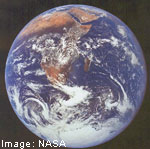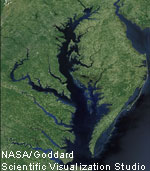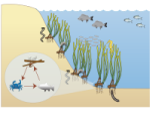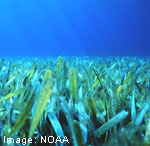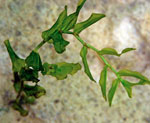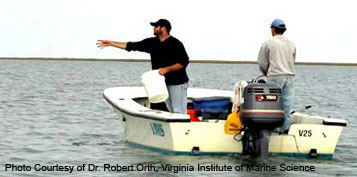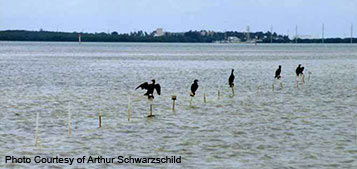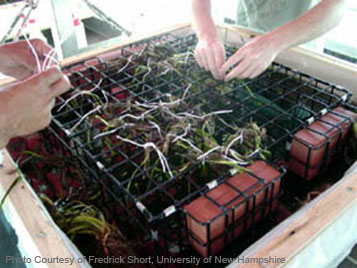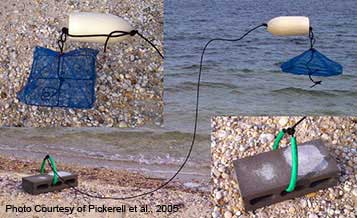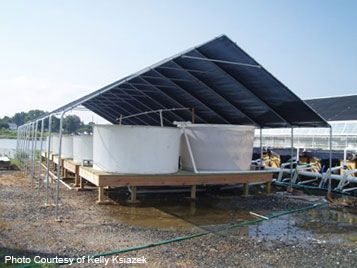Global Research to Better Understand Seagrasses in their Environment
Seagrass scientists around the world are currently investigating many aspects of how and where seagrasses grow and how they interact with their surrounding environment. This knowledge helps to better predict when human activities might cause damage to seagrasses and the animals that depend upon them. Most of the research has been done in Europe, North America and Australia – so there is still a lot to learn, especially about tropical seagrass. Scientists ask questions at all scales from a single seagrass shoot all the way up to the whole world, the table below details talks about the types of questions researchers are asking and why it is important.
Scale | What is the question? | Why is it important? | |
Global | Where do we find seagrasses? | Different types of seagrass live in different conditions (for example different temperatures), with global warming, distribution of seagrass may change. | |
Ecosystem | How do seagrasses reproduce and how closely related (genetics) are they? | Studying seagrass genetics and reproduction tells scientists how well they might be able to cope with change (eg due to pollution or climate change). | |
Habitat | What animals live in seagrass meadows and why do they live there? Can seagrasses reduce the size of waves? | Seagrasses support many important fisheries species, and slow down water movement which helps to stop shorelines and marshes from eroding. | |
Meadow | How fast do seagrasses grow and how much sunlight do they need? | Water quality is declining in many places where seagrasses grow, understanding how they grow helps us to know "how much pollution is too much." | |
Shoot | How much gas can seagrasses pump? | Oxygen that seagrasses produce and pump into the sediments can to some extent help them survive low oxygen, but as dead zones increase, this research helps to define "how low can they go?" |
Research Into Seagrass Restoration
Worldwide, scientists and community members are attempting to slow the decline of seagrass or replant and restore those meadows that have disappeared. Techniques used for restoration depend on the scale of the decline, the species used, and the conditions of the area to be restored. Restoration is done by either transplanting adult plants or collecting seeds from an existing meadow and spreading them in a restoration area. Links to techniques.
Seed Broadcasting
A seeding technique was used to restore the seagrass meadows in the Virginia Coastal Bays. Flowering shoots were collected from existing seagrass meadows in the Chesapeake Bay and other coastal bays and kept in large tanks until the seeds matured. Once mature, seeds drop from the plant and sink to the bottom. Researchers picked the seeds from the bottom of the tank and determined which were good based on their color and weight. At the restoration site, seeds were broadcast from a boat into the water where they sank, germinated, and grew into new plants.
Bird Stakes
A creative method has proven useful in the restoration of areas impacted by boat scars in the Florida Keys where the water is nutrient-poor, and consequently plant growth is often slow. Scientists have put stakes in the ground in these scarred areas that birds use as a perch. The nutrient-rich bird feces stimulates seagrass growth and makes the recovery more rapid.
Transplanting Eelgrass Remotely with Frame System (TERFS)
Planting individual shoots by hand is time consuming and tedious, and as a result usually only small areas can be covered using this technique. Frederick Short of the University of New Hampshire developed a new method — Transplanting Eelgrass Remotely with Frame System (TERFS) — to make planting larger areas easier. Two hundred shoots of eelgrass are tied to a plastic frame with biodegradable ties. The frame can be dropped onto the sediment floor from a boat. After the ties have degraded (several weeks later) the frames are removed and the shoots remain in place and hopefully begin expanding by producing new shoots from horizontal stems under the sediment.
Buoy Deployed Seeding (BuDS)
Seed broadcasting has proven successful in the Virginia Coastal Bays; however, that method requires the money and space for large flowing seawater tanks to hold the flowering shoots until the seeds drop off. A method of seed dispersal was developed recently to avoid the hassle of processing the seeds. The BuDS system enables flowers to be taken directly from the area where they are picked to the restoration site, without having to use the holding tanks. Flowers are taken from existing beds and placed in mesh bags. The mesh bags are attached to a float and anchored to the bottom with a brick. The flowers develop over time, and as seeds mature, they fall from the flower through the mesh onto the sediment surface. There they develop into small seedlings and hopefully create a lush, new seagrass meadow (Pickerell et al. 2005).
Conservation
Restoration is costly, time consuming, and not always 100% successful. Conservation is often more inexpensive and efficient. However, it is unfortunately not extremely common. Seagrasses are barometers of water quality because they are sensitive to changes in light that occur as nutrients and sediments cloud the water. In this sense, they are like the “canaries in the coal mine”– their decline means that the quality of the coastal waters is also declining.
National laws help protect seagrasses in different ways. Section 404 of the Clean Water Act protects seagrass by controlling the disposal of dredge materials (sediment which is removed to keep the water deep for boating traffic) which can block light and kill seagrasses. Section 10 of the Rivers and Harbors Act protects seagrasses by regulating the building of structures in the water, which can block light or water flow to seagrasses and kill them. The Endangered Species Act protects one species of seagrass, Johnson’s seagrass (Halophilia johnsonii) and lists all other species as critical for fish habitats. Throughout the nation, local laws protect seagrasses by limiting boating and fishing access in sensitive areas. Regulations that limit the amount of fertilizer and chemicals dumped into waterways from populated areas can also benefit these plants.
Scientists Talking About Restoration

